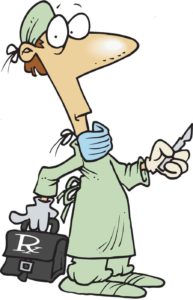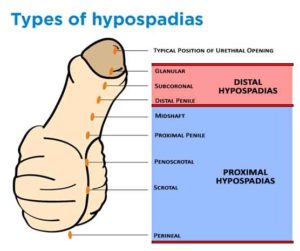A distal hypospadias describes a hypospadias where the opening of the pee tube opens just below where it should. This page gives some information about the surgery to repair a distal hypospadias.
Click here for more information on HYPOSPADIAS.
How is the operation done?
The operation is usually done as a day case procedure - meaning that you come in and go home on the same day. Occasionally there may be a surgical or anaesthetic reason to recommend an overnight stay. This will be discussed with you at the time of surgery.
Anaesthetic
The operation is done with the patient asleep under a Full General Anaesthetic.
As well as the general anaesthetic the patient will often have a Caudal Block. This is a special block where local anaesthetic is injected into the back and is a very effective method of pain relief after the surgery.
The Surgery
There are a number of parts to the surgery:
- Need to recreate a pee tube (urethra) so that it opens up in the correct position
- Correct any curve (chordee) of the penis
- Reconstruct the penis around the pee tube
- Deal with the foreskin
When your son returns from the theatre, they will have dressings on the penis, and a tube (catheter or stent) coming out through the dressings. The tube goes into their bladder and allows the urine to come out without affecting the hypospadias repair. If the young person is still in nappies they will have 2 nappies on. If they have been toilet trained then the tube will attach to a valve or a leg bag. How these are managed will be explained to you when you attend for the surgery.
What are the options for dealing with the foreskin?
There are 2 options for managing the foreskin:
- Reconstruct the foreskin so that the boy looks uncircumcised. This has the advantage that it reduces the risks of complications such as developing a fistula. It also means that if there are complications and a skin graft is needed, the foreskin is still available.
- Remove the foreskin so that the boy looks circumcised. This is associated with a higher risk of complications from the repair.
These options will be discussed with you by your surgeon.
How long will the surgery take?
The surgery takes just over an hour if it is uncomplicated. This does not include the time for the anaesthetic or recovery after the anaesthetic.
Are there any risks to the surgery?
All operations carry risks. Hypospadias surgery is no different. The risks include:
- BLEEDING - It is not uncommon to see blood in the nappy after the surgery. If bleeding does occur after the operation it is often possible to control the bleeding by appealing pressure to the penis. Very occasionally it is necessary to take someone back to theatre to trat the bleeding.
- INFECTION - this can be in the repair or in the waterworks. Your son will be given antibiotics in theatre to reduce this risk.
- FISTULA FORMATION - A fistula is an abnormal connection between the pee tube and the outside world. If a fistula develops it needs another operation to fix it. The risk of developing a fistula is around 5%
- DEHISCENCE - Very rarely the whole repair can come apart. This is more likely to happen if there is a bad infection of the repair. If there is a dehiscence it means the whole repair has to be done all over again. The risk of having a dehiscence is very small.
- URETHRAL STRICTURE - This means developing a narrowing in the pee tube. It most often happens at the join between the boys own pee tube and the pee tube that is made during the repair. If there is a narrowing it may need to be stretched up. This is a risk that is present until the young person reaches adulthood.
- COSMESIS - Sometimes people do not like the cosmetic result following a hypospadias repair. Sometimes there are things that can be done to improve the appearance.
What Happens after the operation?
After the operation your son will wake up and be able to have something to eat and drink straight away. Most children who have this operation go home the same day. This may not be possible if your son is very young, has other medical problems or something unexpected happened during the operation.
It is not uncommon for children to feel a bit sick for the first 24 hours after an anaesthetic. You should encourage your son to drink lots of fluid. As long as he is drinking it does not matter if he is off his food for a day or two.
Give your son regular pain relief for the first couple of days after the operation. Giving pain killers regularly is much more effective that waiting for someone to complain of pain before giving them something.
An appointment will be made to remove the dressings around 1 week after the operation. You will then be reviewed 6 months later to see how things have healed up.
Occasionally the dressings can come off before the week is up. This often means that parents can find a length of the tube (stent) hanging out. If that happens you should pull the rest of the stent out. This will not hurt your son. Leaving the stent hanging out can be very uncomfortable. After the stent has been removed you should let the hospital know that this has happened.
You should call the ward or your family doctor (GP) if:
- Your child is in a lot of pain and pain relief does not seem to help
- Your child has a high temperature and paracetamol does not bring it down
- Your child is not passing urine from the stent / catheter or the stent / catheter has come out.
- Your child is bleeding
The information provided in this website is meant to provide general information only. It does not replace a consultation with a doctor who will be able to give you information tailored to the patient.

